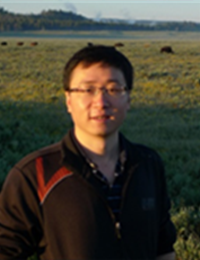LIU Zhiduo

LIU Zhiduo
Email: Zhiduo.liu@shsmu.edu.cn
Tel: 021-63846590-776749
Laboratory of Immune Microenvironment
Lab: Immune microenvironment
Research Field
We are interested in the dissection of the critical role of macrophages in shaping immune responses in the tissue microenvironment, particularly including (i) how the tissue resident macrophages interact with the stromal cells and further promote their activation and differentiation, which would in turn impact the local immune response; (ii) the novel mechanisms underlying the regulation of inflammatory responses mediated by macrophages, which are involved in the local tissue damage or tumor development. Our research will provide insight into complex regulation of immune response and have important implications for immunotherapy development.
Personal Introduction
Zhiduo Liu received his bachelor's degree from Wuhan University in 2001, and his Ph.D. from Shanghai Institute of Biochemistry and Cell Biology, Chinese Academy of Sciences in 2010. He received the postdoctoral training in Laboratory of Systems Biology, National Institute of Allergy and Infectious Diseases, National Institutes of Health from 2010 to 2016. In September 2016, Zhiduo Liu joined the Shanghai Institute of Immunology, Shanghai Jiao Tong University School of Medicine. He is the principal investigator of the immune microenvironment team and the head of the imaging core facility of the Shanghai Institute of Immunology. Zhiduo Liu won the NIH "William E. Paul Prize" in 2016.
Education
1997-2001 B.S., Wuhan University, Wuhan, China
2001-2009 Ph.D., Institute of Biochemistry and Cell Biology, Shanghai Institutes for Biological Sciences, Chinese Academy of Sciences, Shanghai, China (Mentor: Dr. Bing Sun)
Academic positions/employment/experience
2009-2010 Research Assistant, Institute of Biochemistry and Cell Biology, Shanghai Institutes for Biological Sciences, Chinese Academy of Sciences, China
2010-2016 Postdoctoral Fellow, Laboratory of Systems Biology, National Institute of Allergy and Infectious Diseases, National Institutes of Health, Bethesda, MD, USA (Mentor: Dr. Ronald N. Germain)
2016-present Principal Investigator, Shanghai Institute of Immunology, Shanghai Jiao Tong University School of Medicine, Shanghai, China
Publications
Liu Z, Gerner MY, Van Panhuys N, Levine AG, Rudensky AY, Germain RN. Immune homeostasis enforced by co-localized effector and regulatory T cells. Nature. 2015 Dec 10;528(7581):225-30. doi: 10.1038/nature16169. Epub 2015 Nov 25. (highlighted by “Immunology: In the right place at the right time.” Nature. 2015 Dec 10;528(7581):205-6.; recommended by Faculty of 1000.)
Yu X#, Teng XL#, Wang F#, Zheng Y#, Qu G, Zhou Y, Hu Z, Wu Z, Chang Y, Chen L, Li HB, Su B, Lu L*, Liu Z*, Sun SC*, Zou Q*. Metabolic control of regulatory T cell stability and function by TRAF3IP3 at the lysosome. J Exp Med. 2018, 215(9):2463-2476. (Co-correspondence)
Wu N#, Sun H#, Zhao X, Zhang Y, Tan J, Qi Y, Wang Q, Ng M, Liu Z, He L, Niu X, Chen L, Liu Z, Li HB, Zeng YA, Roulis M, Liu D, Cheng J, Zhou B, Ng LG, Zou D, Ye Y, Flavell RA, Ginhoux F, Su B.MAP3K2-regulated intestinal stromal cells define a distinct stem cell niche. Nature, 2021 Apr;592(7855): 606-610.
Guan C, Huang X, Yue J, Xiang H, Shaheen S, Jiang Z, Tao Y, Tu J, Liu Z, Yao Y, Yang W, Hou Z, Liu J, Yang XD, Zou Q, Su B, Liu Z, Ni J*, Cheng J*, Wu X*. SIRT3-mediated deacetylation of NLRC4 promotes inflammasome activation. Theranostics. 2021 Feb 15; 11(8):3981-3995.
Jin F#, Li J#, Zhang YB#, Liu X#, Cai M, Liu M, Li M, Ma C, Yue R, Zhu Y, Lai R, Wang Z, Ji X, Wei H, Dong J, Liu Z, Wang Y*, Sun Y*, Wang X*. A functional motif of long noncoding RNA Nron against osteoporosis. Nat Commun. 2021 Jun 3; 12(1):3319.
Yang XD#*, Li W, Zhang S, Wu D, Jiang X, Tan R, Niu X, Wang Q, Wu X, Liu Z, Chen LF, Qin J, Su B*. PLK4 deubiquitination by Spata2-CYLD suppresses NEK7-mediated NLRP3 inflammasome activation at the centrosome. EMBO J. 2020, 39(2):e102201.
Liu Z, Gu Y, Chakarov S, Bleriot C, Kwok I, Chen X, Shin A, Huang W, Dress RJ, Dutertre CA, Schlitzer A, Chen J, Ng LG, Wang H, Liu Z, Su B*, Ginhoux F*. Fate Mapping via Ms4a3-Expression History Traces Monocyte-Derived Cells. Cell. 2019, 178(6):1509-1525.e19.
Oyler-Yaniv A, Oyler-Yaniv J, Whitlock BM, Liu Z, Germain RN, Huse M, Altan-Bonnet G, Krichevsky O. A Tunable Diffusion-Consumption Mechanism of Cytokine Propagation Enables Plasticity in Cell-to-Cell Communication in the Immune System. Immunity. 2017 Apr 18;46(4):609-620.
Veres TZ, Kopcsányi T, van Panhuys N, Gerner MY, Liu Z, Rantakari P, Dunkel J, Miyasaka M, Salmi M, Jalkanen S, Germain RN. Allergen-Induced CD4+ T Cell Cytokine Production within Airway Mucosal Dendritic Cell-T Cell Clusters Drives the Local Recruitment of Myeloid Effector Cells. J Immunol. 2017 Jan 15;198(2):895-907.
Lo B, Zhang K, Lu W, Zheng L, Zhang Q, Kanellopoulou C, Zhang Y, Liu Z, Fritz JM, Marsh R, Husami A, Kissell D, Nortman S, Chaturvedi V, Haines H, Young LR, Mo J, Filipovich AH, Bleesing JJ, Mustillo P, Stephens M, Rueda CM, Chougnet CA, Hoebe K, McElwee J, Hughes JD, Karakoc-Aydiner E, Matthews HF, Price S, Su HC, Rao VK, Lenardo MJ, Jordan MB. AUTOIMMUNE DISEASE. Patients with LRBA deficiency show CTLA4 loss and immune dysregulation responsive to abatacept therapy. Science. 2015 Jul 24;349(6246):436-40.
Li Z, Zhang Y, Liu Z, Wu X, Zheng Y, Tao Z, Mao K, Wang J, Lin G, Tian L, Ji Y, Qin M, Sun S, Zhu X, Sun B. ECM1 controls T(H)2 cell egress from lymph nodes through re-expression of S1P(1). Nat. Immunol. 2011 Feb;12(2):178-85.




